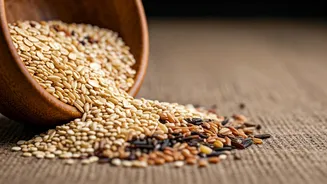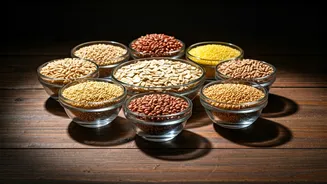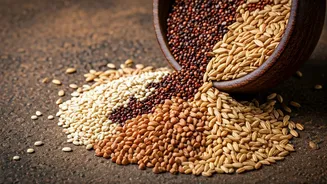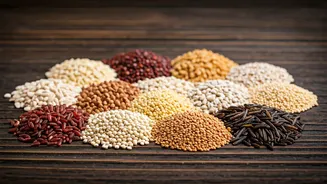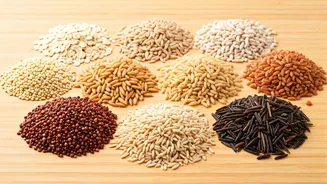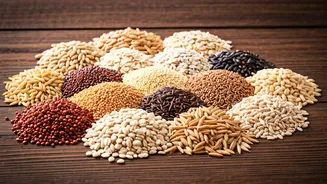Embrace Whole Grains
Managing diabetes involves making careful dietary choices, and incorporating whole grains is a smart strategy. Unlike refined grains, whole grains retain
their bran, germ, and endosperm, providing fiber, vitamins, and minerals. Fiber plays a crucial role in slowing down the absorption of sugar, which prevents sharp spikes in blood glucose. Moreover, these grains typically have a lower glycemic index (GI), indicating that they release glucose more gradually into the bloodstream. Including whole grains in your daily meals can lead to improved blood sugar control, reduce insulin resistance, and support weight management. It's about making conscious, informed food choices to live a more balanced, healthier life with diabetes, potentially reversing issues associated with blood sugar irregularities.
Oats: Fiber Powerhouse
Oats stand out as a breakfast staple that’s especially helpful for managing blood sugar. The high soluble fiber content, particularly beta-glucan, helps slow glucose absorption, preventing drastic blood sugar increases after meals. Research indicates that regular oat consumption can improve both glycemic control and insulin sensitivity. In addition to blood sugar benefits, oats provide sustained energy, helping manage hunger and support weight control. They can be cooked as oatmeal, added to smoothies, or incorporated into baked goods to provide a nutritious and tasty addition to your meals. Moreover, the versatility of oats makes them a convenient and easy-to-include element in a diabetic-friendly eating plan, assisting with managing healthy blood glucose levels and overall well-being.
Quinoa's Nutritional Profile
Quinoa is a nutritional powerhouse often referred to as a ‘superfood.’ Despite being a seed, it is usually prepared and eaten like a grain and is a complete protein, containing all nine essential amino acids. Its high fiber content aids in slowing down glucose absorption, which reduces blood sugar spikes. Moreover, quinoa boasts a low glycemic index, making it suitable for people with diabetes. Its high levels of magnesium and other minerals support blood sugar regulation. Preparing quinoa is simple, and it can be used in salads, as a side dish, or in place of rice. This grain offers a versatile and nourishing option to maintain a healthy blood sugar balance and offers a great array of nutrients to your overall diet, making it a valuable part of any balanced diet.
Barley: Beta-Glucan Benefits
Barley is another grain rich in beta-glucan fiber, contributing to slower glucose absorption and better blood sugar control. Studies have shown barley’s capacity to lower post-meal blood sugar levels and improve insulin sensitivity. It also helps in improving cholesterol levels and promoting heart health. Barley can be used in soups, stews, or salads, and it's also available in pearled and hulled forms; hulled barley retains more nutrients. The integration of barley into meals can support overall health and enhance the management of diabetes through a balanced nutritional intake. Eating barley regularly could help in maintaining a steady supply of energy.
Brown Rice: Fiber and Minerals
Brown rice, in comparison to white rice, is a whole grain that retains its bran and germ, giving it a higher fiber content. This fiber helps moderate glucose absorption, supporting the prevention of drastic blood sugar fluctuations. It also contains magnesium, which assists in improving insulin sensitivity. Brown rice can be substituted for white rice in numerous dishes, such as stir-fries, curries, and side dishes. Making this simple switch can lead to significant positive changes in blood sugar management and overall health. Furthermore, brown rice offers essential nutrients, making it a valuable element of a balanced diet that aids in the management of diabetes.
Buckwheat: Unique Benefits
Buckwheat is often mistaken for a grain but is actually a seed related to rhubarb and sorrel. It's gluten-free and has a low glycemic index, making it a safe choice for people with diabetes. Buckwheat is rich in rutin, an antioxidant that may improve blood sugar control. It can be used in pancakes, noodles (soba noodles), and as a breakfast porridge. Buckwheat’s distinctive nutritional profile contributes to its capacity to regulate blood sugar, and provides other health advantages. Its versatility in cooking, combined with its positive impact on blood sugar levels, makes it a valuable food choice for those seeking to manage diabetes.
Bulgur: Quick and Nutritious
Bulgur is a whole grain made from wheat kernels that have been parboiled, dried, and cracked. It has a low to moderate glycemic index, making it a great choice for those with diabetes. Its high fiber content helps stabilize blood sugar levels, and it’s quick to cook, making it a convenient option. Bulgur can be used in salads, such as tabbouleh, as a stuffing for vegetables, or as a side dish. Including bulgur in your diet can support blood sugar control and provides a good source of fiber, and other nutrients. This versatile grain combines ease of preparation with significant health benefits, making it an excellent addition to a healthy eating plan.
Millet: Versatile and Nutritious
Millet is a gluten-free grain that is easy to digest and rich in nutrients, making it a good selection for individuals managing diabetes. It has a relatively low glycemic index, meaning it causes a slower rise in blood sugar levels after eating. Millet provides important minerals, such as magnesium, that can improve insulin sensitivity. This grain can be cooked as a porridge, added to salads, or used as a base for dishes. Its mild flavor and versatility make it simple to include in multiple meals throughout the week. By incorporating millet into your diet, you can enjoy a nutritious meal that helps to regulate blood sugar levels, assisting in the management of your overall health.
Amaranth: High in Protein
Amaranth, like quinoa, is a seed commonly used as a grain and is packed with nutrients, including protein, fiber, and important minerals. Its high fiber content helps manage blood sugar levels, and it has a moderate glycemic index, which makes it a good option for diabetics. It is also a complete protein source, providing all essential amino acids. Amaranth can be cooked as a porridge, used in soups, or popped like popcorn. Its unique nutritional profile and versatility make it a beneficial choice for those trying to incorporate more health-conscious options in their eating plan. It contributes to balanced blood sugar management, providing a range of nutrients crucial for a healthy lifestyle.
Whole Wheat: Fiber Benefits
Whole wheat, with its bran, germ, and endosperm intact, offers more fiber than refined wheat products. This additional fiber slows down glucose absorption, which prevents drastic spikes in blood sugar, making it beneficial for people with diabetes. Whole wheat has a moderate glycemic index, which means it causes a slower, steadier release of glucose into the bloodstream. It can be found in a range of products, including bread, pasta, and crackers. Opting for whole wheat options can lead to improved blood sugar control and provide crucial nutrients that support overall health. Integrating whole wheat into your meals is a straightforward and effective method for better diabetes management and an improved quality of life.
